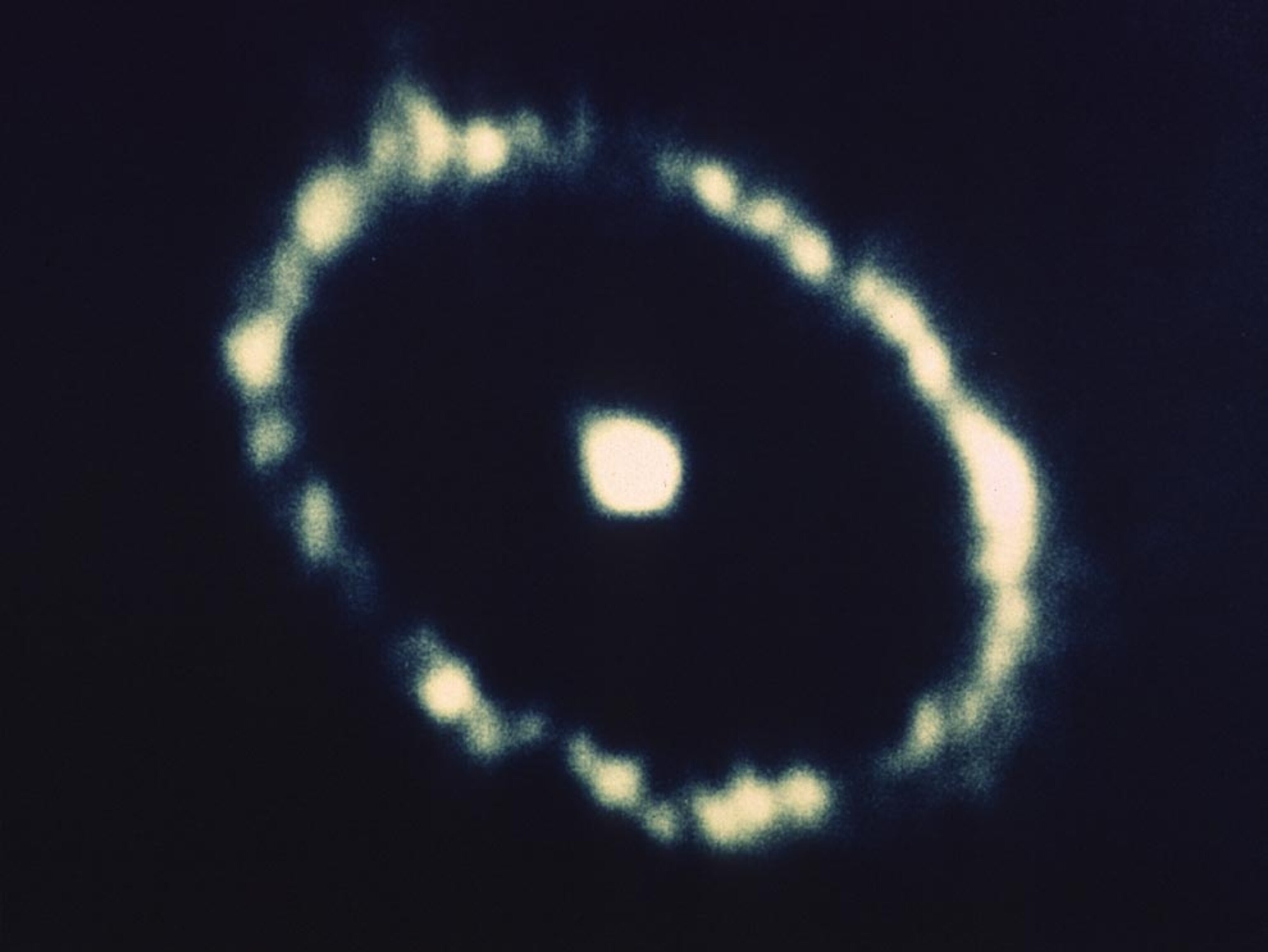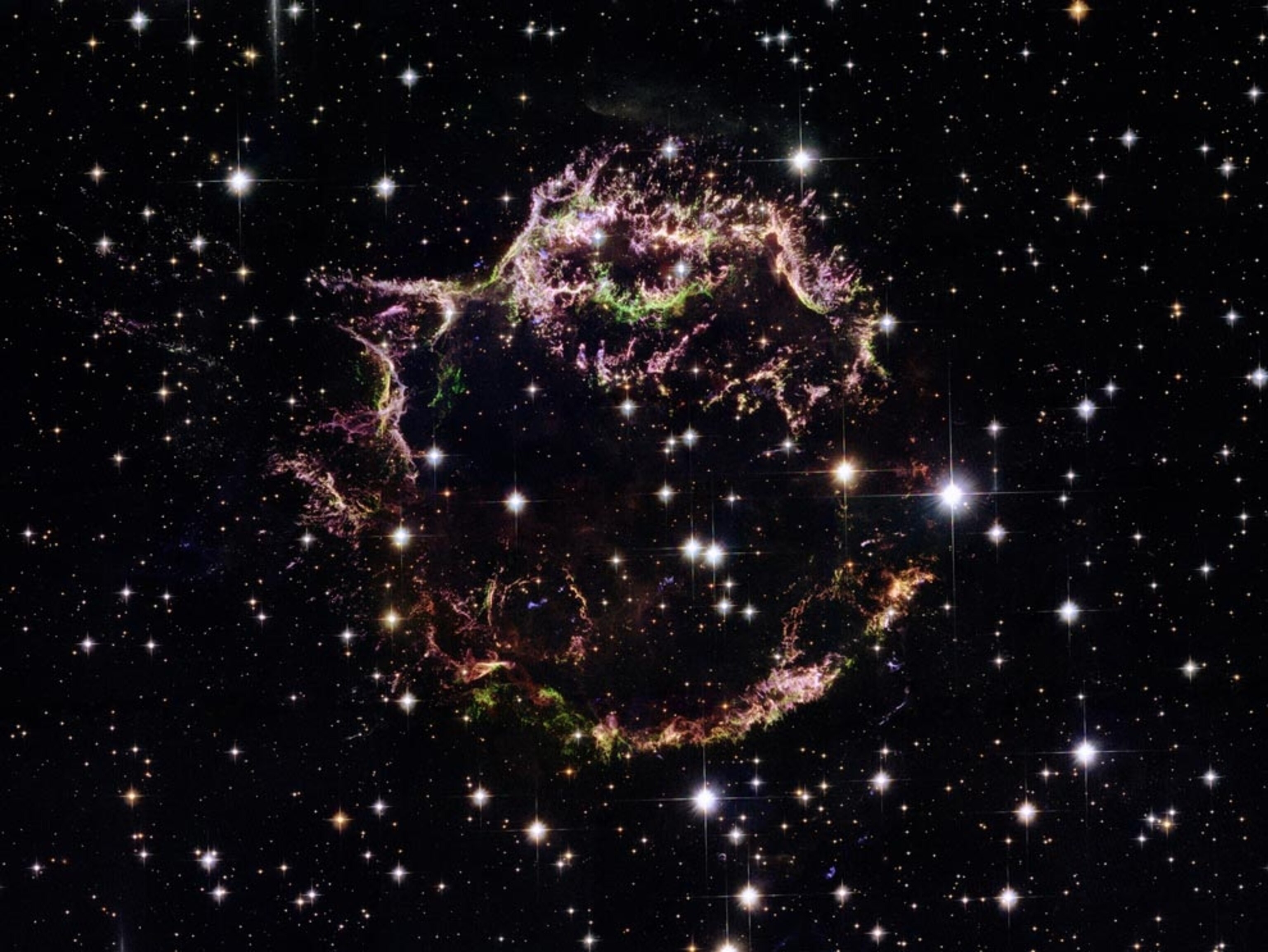Some stars burn out instead of fading. These stars end their evolutions in massive cosmic explosions known as supernovae.
When supernovae explode, they jettison matter into space at some 9,000 to 25,000 miles (15,000 to 40,000 kilometers) per second. These blasts produce much of the material in the universe—including some elements, like iron, which make up our planet and even ourselves. Heavy elements are only produced in supernovae, so all of us carry the remnants of these distant explosions within our own bodies.
Supernovae add enriching elements to space clouds of dust and gas, further interstellar diversity, and produce a shock wave that compresses clouds of gas to aid new star formation.
But only a select few stars become supernovae. Many stars cool in later life to end their days as white dwarfs and, later, black dwarfs.
Star Fusion
But massive stars, many times larger than our own sun, may create a supernova when their core's fusion process runs out of fuel. Star fusion provides a constant outward pressure, which exists in balance with the star's own mass-driven, inward gravitational pull. When fusion slows, outbound pressure drops and the star's core begins to condense under gravity—becoming ever denser and hotter.
To outward appearances, such stars begin growing, swelling into bodies known as red supergiants. But at their cores, shrinking continues, making a supernova imminent.
When a star's core contracts to a critical point, a series of nuclear reactions is unleashed. This fusion staves off core collapse for a time—but only until the core is composed largely of iron, which can no longer sustain star fusion.
In a microsecond, the core may reach temperatures of billions of degrees Celsius. Iron atoms become crushed so closely together that the repulsive forces of their nuclei create a recoil of the squeezed core—a bounce that causes the star to explode as a supernova and give birth to an enormous, superheated, shock wave.
White Dwarfs & Black Holes
Supernovae also occur in binary star systems. Smaller stars, up to eight times the mass of our own sun, typically evolve into white dwarves. A star condensed to this size, about that of Earth, is very dense and thus has strong enough gravitational pull to gather material from the system's second star if it is close enough.
If a white dwarf takes on enough mass it reaches a level called the Chandrasekhar Limit. At this point the pressure at its center will become so great that runaway fusion occurs and the star detonates in a thermonuclear supernova.
A supernova can light the sky up for weeks, and the massive transfer of matter and energy leaves behind a very different star.
Typically only a tiny core of neutrons, a spinning neutron star, is left to evidence a supernova. Neutron stars give off radio waves in a steady stream or, as pulsars, in intermittent bursts.
If a star was so massive (at least ten times the size of our sun) that it leaves behind a large core, a new phenomenon will occur. Because such a burned-out core has no energy source to fuse, and thus produces no outward pressure, it may become engulfed by its own gravity and turn into a cosmic sinkhole for energy and matter—a black hole.
Related Topics
You May Also Like
Go Further
Animals
- How can we protect grizzlies from their biggest threat—trains?How can we protect grizzlies from their biggest threat—trains?
- This ‘saber-toothed’ salmon wasn’t quite what we thoughtThis ‘saber-toothed’ salmon wasn’t quite what we thought
- Why this rhino-zebra friendship makes perfect senseWhy this rhino-zebra friendship makes perfect sense
- When did bioluminescence evolve? It’s older than we thought.When did bioluminescence evolve? It’s older than we thought.
- Soy, skim … spider. Are any of these technically milk?Soy, skim … spider. Are any of these technically milk?
Environment
- Are the Great Lakes the key to solving America’s emissions conundrum?Are the Great Lakes the key to solving America’s emissions conundrum?
- The world’s historic sites face climate change. Can Petra lead the way?The world’s historic sites face climate change. Can Petra lead the way?
- This pristine piece of the Amazon shows nature’s resilienceThis pristine piece of the Amazon shows nature’s resilience
- Listen to 30 years of climate change transformed into haunting musicListen to 30 years of climate change transformed into haunting music
History & Culture
- Meet the original members of the tortured poets departmentMeet the original members of the tortured poets department
- Séances at the White House? Why these first ladies turned to the occultSéances at the White House? Why these first ladies turned to the occult
- Gambling is everywhere now. When is that a problem?Gambling is everywhere now. When is that a problem?
- Beauty is pain—at least it was in 17th-century SpainBeauty is pain—at least it was in 17th-century Spain
Science
- Here's how astronomers found one of the rarest phenomenons in spaceHere's how astronomers found one of the rarest phenomenons in space
- Not an extrovert or introvert? There’s a word for that.Not an extrovert or introvert? There’s a word for that.
- NASA has a plan to clean up space junk—but is going green enough?NASA has a plan to clean up space junk—but is going green enough?
- Soy, skim … spider. Are any of these technically milk?Soy, skim … spider. Are any of these technically milk?
Travel
- How to see Mexico's Baja California beyond the beachesHow to see Mexico's Baja California beyond the beaches
- Could Mexico's Chepe Express be the ultimate slow rail adventure?Could Mexico's Chepe Express be the ultimate slow rail adventure?








